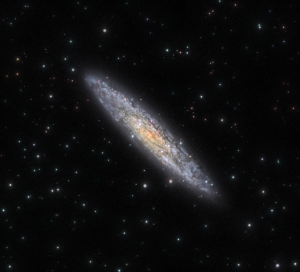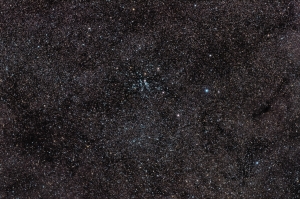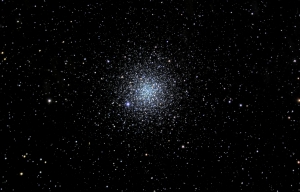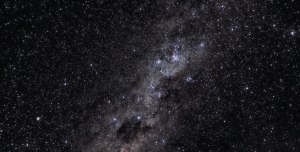Now for something different…
I’ve always been an avid astronomy hobbyist, ever since I spent my teen years at Siding Spring Observatory — Australia’s largest professional site for optical observations. My Dad worked (and we lived) onsite, as an electronics technician keeping the critical equipment running. As a consequence, I got to live on a mountain, in a national park, and be exposed to real science from an early age!
Anyway, I’ve recently had a chance to take up my amateur astronomy pursuits again, and this time to try my hand at some astrophotography. I own good-quality but relatively inexpensive equipment right now (most of my imaging to date has been done through an 80mm ED refractor and either a Sony NEX-3 DSLR camera or an Orion StarShoot G3 monochrome CCD). Apparently astrophotography is a bottomless money pit — there is always the next upgrade to look to! But one step at a time.
Anyway, here are a few of my recent images that I thought you might enjoy — or want to critique. They were taken in the relatively light-polluted skies of suburban Adelaide, but I’ll soon (in one month, in fact) be moving to a much darker site in southern Tasmania. Did I tell you all that I’ve taken a new job at the University of Tasmania?
Here is the selected gallery, with full capture details and higher-rez versions in the link to the Astrobin AP hosting website.
NGC 253, the ‘Silver Coin’ galaxy in Sculptor (http://www.astrobin.com/118924)
M42, the Orion Nebula (details here: http://www.astrobin.com/117345)
M25, an open cluster in the rich star cloud of Sagittarius (details here: http://www.astrobin.com/110631)
M8 (Lagoon) and M20 (Trifid) Nebulae in wide field (details here: http://www.astrobin.com/114602)
NGC 6752 – Great Peacock Globular cluster (details here: http://www.astrobin.com/112389)
NGC 3372 Keyhole Nebula with Eta Carina (details here: http://www.astrobin.com/98885)
Crux to Carina, a nightscape of southern constellations (details here: http://www.astrobin.com/95168)
Hope you enjoy!








13 replies on “Deep Space”
Congrats on your move south, Barry.
I found that I am not patient enough for astronomy, nor sufficiently good at mathematics. This partially explains why I became an engineer. A year or two back I culled my old university texts, including several astronomy ones circa 1966. A quick flick through these books which pre-date space-based telescopes and supercomputers was very sobering.
How fleeting our knowledge is if not used and refreshed.
LikeLike
Hi Barry,
tell us more about your new role. When I rave about your site, I can’t refer to you as the head of climate at Adelaide any more?
PS: Loving the photo’s. They feed the sci-fi dreamer in me. How does the camera navigation system work? Is it GPS software guided, or do you have to find some points in the sky and navigate from them?
LikeLike
Have you ever had the urge to actually go up into space? Come visit us here in New Mexico and take a shot from Spaceport America. It is a bit expensive, but if I can pass the physical I might just take a chunk of my savings and do this one last road trip without the road.
LikeLike
Hi Barry, Congratulations on your new job in Tasmania and also for all of the stirling work you’ve been doing in the interests of nuclear power over the past few years. I’ve been plugging away on my own but feel that I’ve made some progress especially over the past three years. I’ll keep trying to educate the people and the politicians into an acceptance of nuclear power especially for South Australia. Did you see my letter to the editor of the Advertiser last week.?It was my vision statement, now ten years old for development in South Australia, based on our enormous uranium reserves. It was first printed in the Adelaide Review in September 2009, five years ago. And I’m now in my 17th year of speaking and writing about it. A recent effort saw me sending a “submission” to the SA Resources Infrastructure Taskforce. Can’t remember if I sent you a copy and so I attach one now. All the best Barry for your new life in Tassie.
Cheers
Terry Krieg
LikeLike
Barry,
Gorgeous photos! It’s remarkable what you have done with fairly inexpensive equipment.
LikeLike
Thanks for the comments everyone!
Eclipse, once polar aligned, you can used computerized systems these days to quickly find and lock onto targets. The celestial coordinate system is very similar to Lat/Long on maps. Once calibrated, you just ‘dial in’ your target using software-driven mounts.
Martin, yes, the plan still is to explore the galaxy at some point, perhaps when my persona has been replicated preciselyl by a simulant sometime after 2050!
At UTAS, I’ll be “Professor of Environmental Sustainability”. A pretty broad canvass to paint, I think! I’ll be based at the new Institute for Future Landscape and Ecosystems, which is a cross-disciplinary research hub. So I’ll retain my diverse interests.
Huon – an amusing aside. My new place is located in the Huon Valley, just west of Huonville. I’ve called our property Huon Ridge. But it is not actually named after you…
LikeLike
I hope you will be able to carry on the same work in your new position at the University of Tasmania. You have made a valuable contribution while at the University of Adelaide.
LikeLike
Barry,
All the best in your new position. Hope you can keep BNC going and hope your new position will enable you to continue to inform the public, media, bureaucrats and politicians about what really is sustainable energy. More important is to explain how we can get it to be an economically viable option. Because, once people understand that then everyone can be winners.
Is there a good dam site in your valley so we can build a pumped storage hydro facility to work with the truly sustainable baseload generators? :)
LikeLike
Welcome to southern Tasmania! Are you putting the old NTU band back together with Dave Bowman?
Peter, there is already a hydro storage facility in the Huon River catchment, it’s called Lake Pedder :)
LikeLike
Yes, I think a few BNC followers and other people around the world have heard of Lake Pedder :)
You’ve given me the opportunity to correct a mistake in my comment: I meant to say “pumped hydro storage” facility, not :pumped storage hydro” facility. Hope that didn’t cause anyone any confusion.
LikeLike
These are stunningly good images considering the rather limited light gathering power of an 80mm refractor and the suburban location. They are also a tribute to modern digital imaging. I can’t imagine that such results would have been achievable in the old days of film with this equipment. Anybody that has looked through a telescope at any of these objects will know how little light is actually received.
When I was in my teens I built a 6″ Newtonian reflector. I must have been bored. Making telescope primary mirrors by hand is tedious in the extreme. The results were pretty good, but I lost interest.
LikeLike
Thanks quokka – image processing technology (e.g., the ability to capture and then stretch linear digital imaging information, remove gradients, do dark/flat/offset calibration, etc.) along with sub-exposure stacking, have opened up enormous possibilities that were unavailable to the previous generation.
Mark D. – yes, we’re working on it!
LikeLike
Stunning images Barry, looks like you have a severe case of aperture fever!
A few years ago I fabricated an adaptor for a 35mm Minolta body for my 8″ reflector with limited success – looks like digital has really leaped ahead
LikeLike